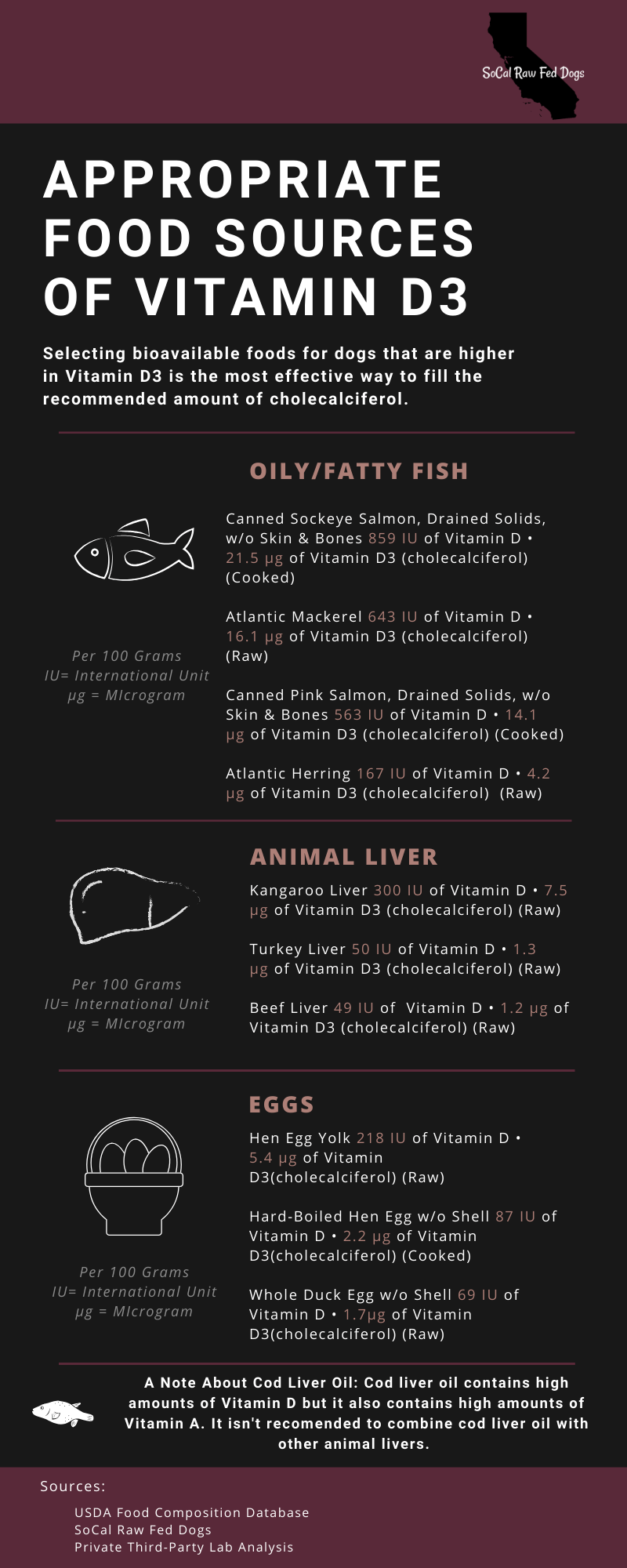Updated August, 2019 to include downloadable suggested food graphic & critical cod liver oil information.
Pssst…
If you’re just here for the Suggested D3 Foods Graphic, you can click or press here to quickly access it or you can learn a little about vitamin D and your dog first & then save it to your device from the graphic below!
An often overlooked and critical component of a raw fed dog’s diet is vitamin D; composed of a group of sterol compounds that regulate calcium and phosphorus metabolism in the body.
There are two pro-vitamin forms of this vitamin.
- Vitamin D2 (ergocalciferol)
- D2 is formed when the compound ergosterol is exposed to ultraviolet radiation (UV Rays). D2 is found in many plants and the conversion is only possible in harvested or “injured” plants, not living plant tissue.
- D2 is only of significance to ruminant & non ruminant herbivores eating sun-dried or irradiated plant materials. D2 is used less efficiently than D3 by dogs.
- Vitamin D3 (cholecalciferol)
- D3 is of great nutritional importance to dogs, and they are dependent on getting it via dietary sourcing because they have limited ability to convert 7-dehydrocholesterol in the skin to cholecalciferol.
*The above information can be found in the article Appropriate Nutrient Levels for Skeletal Development in Large & Giant Breed Puppies
Vitamin D’s Functions
Vitamin D’s functions are intricately involved with normal calcium and phosphorus homeostasis in the body. At the site of the intestine, vitamin D stimulates the synthesis of calcium-binding protein, which is needed for efficient absorption of dietary calcium & phosphorus. Vitamin D affects normal bone growth & calcification by acting with Parathyroid Hormone (PHT) to mobilize calcium from bone and by causing an increase in phosphate reabsorption in the kidneys. <—- What does all that mean?! It means vitamin D’s actions in the intestines, bones, and kidneys creates an increase in plasma calcium and phosphorus, to the level needed for normal mineralization of bone.
Critical Recap: Vitamin D plays an important role in regulating calcium and phosphorus metabolism. A deficiency in vitamin D can impact bone mineralization and cause skeletal issues.
Dietary Recommendations for Vitamin D
Many studies about vitamin D and dogs have been conducted as far back as 1930. The NRC (1985 edition) reviewed studies conducted in 1939, 1944, 1965, & established the minimum guideline for growing dogs to be 2.75 μg (microgram) of vitamin D per 1,000 kcal for growing dogs. In 2002, another study was done and the findings supported previous found data that showed the same. The 2006 revision of the NRC includes the requirements and information on each study that was used in determining that the 1985 established recommendation was still valid. Because there hasn’t been any substantial studies or conclusive findings in typical adults or breeding dogs during pregnancy or lactation; the same amount is recommended for them as is for growing puppies. There is missing information across these studies that may or may not affect Vitamin D recommendations.
For example, a 1991 study on dietary Vitamin D requirement of weanling pups tested the hypothesis that growing dogs do not require supplementation with cholecalciferol (vitamin D-3) in a nonpurified extruded diet. “Twenty-eight weanling pups from four litters of English pointers and two litters of German Shepherd dogs were allotted equally to two groups by gender and weight. Dogs were raised in indoor-outdoor kennel runs for the 102-wk evaluation. One group was fed a diet that contained no added vitamin D while the other group was fed the same diet to which had been added 60.5 micrograms cholecalciferol/kg diet. Both diets contained approximately 14% calcium and 1.0% phosphorus. Growth as measured by body weight and length, serum calcium, phosphorus and alkaline phosphatase and urine hydroxyproline were not significantly different (P greater than 0.05) between the two treatment groups. There was no relationship between dietary treatment and nutritional secondary hyperparathyroidism (NSH), rickets or other skeletal abnormalities. The data support the concept that addition of vitamin D to typical commercial dog foods for purposes of prevention or amelioration of rickets, NSH or other skeletal diseases is unnecessary.”
Food for Thought: There was important data not established when testing the hypothesis such as the basal vitamin D content and also it was stated the calcium and phosphorus levels in the diet were far above respective
requirements. Vitamin D and those minerals interact and therefore additional evaluations are needed for definitive conclusions.
Vitamin D Deficiencies
Vitamin D deficiencies are not as common of a thing as Hypervitaminosis D and deficiencies generally occur over time in adults who aren’t fed adequate amounts. This is not too common.
Critical Note for Puppies: It is crucial to feed a growing puppy fully balanced every day to meet their particular vitamin D needs.
 Suggested Food Sources
Suggested Food Sources
Dietary sources of vitamin D3 for dogs are relatively low with the highest amounts being found in fish, particularly cod liver.
Critical Note: When feeding cod liver oil, a dog owner must use extreme care and attention to the details of every nutrient in the bowl. Cod liver oil is high in vitamin D and it is high in vitamin A. If you have ingredients in the bowl that are already high in either of these vitamins, your dog may become seriously ill. Cod liver oil isn’t an ingredient that should be used outside of a very specific and carefully formulated recipe that can correctly account for all of the nutrient levels/amounts.
Moderate amounts of D3 can be found in foods such as Atlantic mackerel, Atlantic herring, Salmon, whole egg, turkey liver, beef liver, kangaroo liver, beef kidney, domesticated duck meat, and turkey heart. Fish liver oils and cod liver oil are two concentrated food sources of vitamin D-3. The D3 Food Chart that is pictured here can be saved to your device for quick reference. The foods listed all offer vitamin D3 via foods that dogs can eat.
Sources + Citations:
Natural Vitamin D Content in Animal Products, Advances in Nutrition, Volume 4, Issue 4, by Alexandra Schmid, Barbara Walther, (2013)
Some Observations on the Dietary Vitamin D Requirement of Weanling Pups, The Journal of nutrition; D Kealy, R & Lawler, Dennis & L Monti, K. (1991)
The National Research Council’s Nutrient Requirements of Dogs and Cats (NRC 2006)
Small Animal Clinical Nutrition, 5th Edition
Canine and Feline Nutrition, 3rd Edition
USDA Food Composite Database
Third-Party Laboratory Analysis (2015)
Textbook of Small Animal Orthopaedics, 1985
The Vitamin D Council
Vitamin D3 Metabolism in Dogs by, Hazewinkel HA, Tryfonidou, Department of Clinical Sciences of Companion Animals, Utrecht University

I learned a lot and saved the graphic, thanks Amy.
I wish I could get kangaroo liver. Is it worth using cod liver oil instead of actual liver?
Thank you I love the infographic
Great read, I didn’t know any of this and the graphic looks great on my phone.